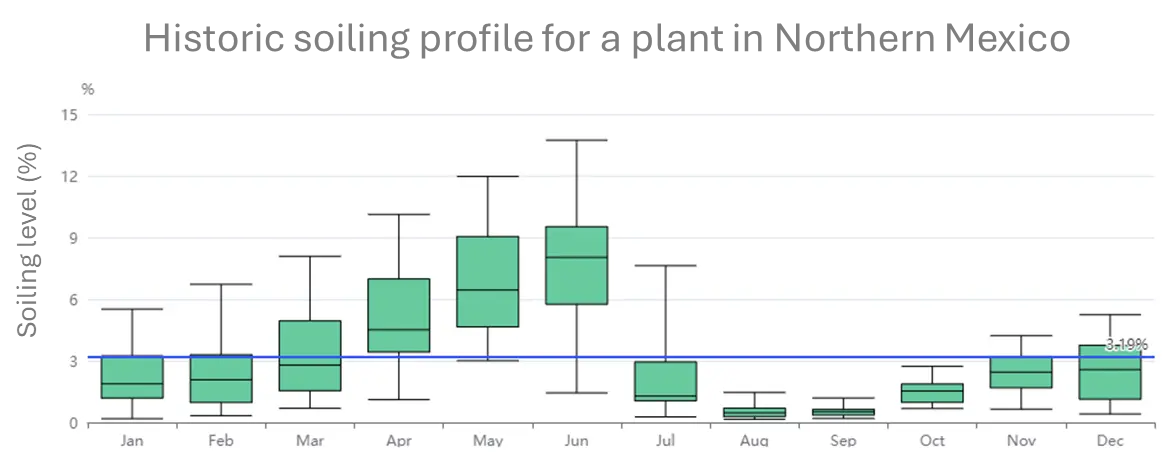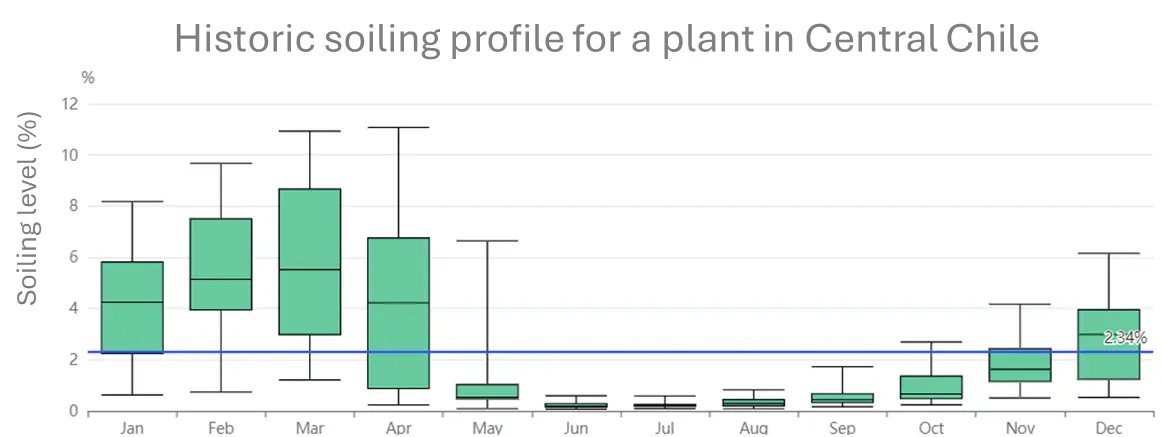Assuming 2% soiling loss threatens project profitability
Assuming a constant 2% soiling loss in PV project development often leads to revenue miscalculations. This flawed practice, common due to time and resource constraints, fails to reflect actual conditions, especially in high-soiling areas. Even in moderate soiling regions like Central Chile, a plant with soiling averaging 2.3% shows how small discrepancies can hide significant effects, as soiling peaks coincide with periods of maximum production. Accurate soiling assessments are essential for realistic energy yield estimates and ensuring project profitability. Decision-makers should prioritize detailed soiling analysis to secure the financial success of PV projects.
Most developers use 2% because they don’t know better
During the early stages of development, it is common industry practice to make assumptions regarding expected soiling loss when estimating the yield for new PV projects. In this regard, 2% tends to be a typical monthly loss factor frequently used in PVSyst for locations worldwide.
This assumption stems from the lack of time and resources to conduct comprehensive soiling analysis (measurement campaigns, historic data analysis, etc.), leading developers to rely on widely used but potentially inaccurate values.
The immediate consequences are the unrealistic estimation of project performance and the allocation of probably insufficient resources to deal with the problem during operation. In the long term, these bad practices result in plant underperformance and reduced profitability.
A clear underestimation on high-soiling sites
In locations with high soiling, the 2% soiling loss assumption is clearly inaccurate. Consider a fixed tilt project located in the Sonora Desert of Western-north Mexico. Historical data analysis carried out with PVRADAR reveals that the plant experiences an average annual soiling loss of 3.1%. Certainly, the assumed 2% is far from reality in such high-soiling environments, and significant consequences in terms of expected plant performance and profitability must be expected.

May seem right for places with less soiling, but it is not
In regions with lower soiling conditions, the error of a 2% assumption is not immediately apparent. Take, for example, a tracker PV plant located in Central Chile, just north of Santiago. Here, the soiling conditions are expected to cause annual losses of about 2.3%, only approximately 15% higher than the assumed 2%. While this difference seems minor, it masks significant underlying issues.

The real difference: Distribution matters
The bottom graph in the figure shows the resulting soiling profile for the plant in Chile based on meteorological data from the last 20 years. Soiling shows high losses during the first part of the year, after which the soiling level tends to decrease as the rainy season approaches and accumulates again once the winter is over. On average, it looks similar to the assumed 2%, but in reality, there is high month-to-month variability.
The difference becomes larger when referring to energy and income. Soiling losses reach their maximum during dry periods, when irradiance is at its highest. The actual loss of 5% in March generates much higher revenue losses than those generated with the 2% assumption. This underestimation is not compensated by the error in the other direction in winter, whose losses are negligible in comparison given the lower plant production.
This seasonal distribution creates a substantial difference in total energy loss, even if a 2% annual estimate initially seems reasonable. Factoring in the energy sales price, the actual expected revenue losses are substantially higher than those calculated with the assumed soiling loss.
Proper soiling analysis favours project profitability
Therefore, even in sites with low to medium soiling losses, relying on assumptions can lead to significant errors in projected revenues. Each PV plant requires a thorough soiling assessment to accurately account for this and other factors. Besides the dry summer-rainy winter dynamic, other sites may experience soiling seasonality due to dust storms, pollen, or nearby industrial activities.
In conclusion, ensuring realistic energy yield estimates and securing project profitability necessitates obtaining an accurate soiling profile. Comprehensive soiling analysis is crucial for accounting for local conditions such as rainfall distribution, seasonal soiling patterns, and local environmental events
